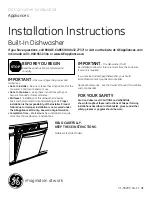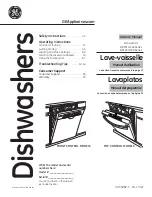
.3.
.4.
S a l t
Salt
The hardness of the water varies from place to place. If hard
water is used in the dishwasher, deposits will form on the dishes
and utensils.
The appliance is equipped with a special softener that uses a salt
specifically designed to eliminate lime and minerals from the water.
Loading the Salt into the Softener
Always use salt intended for use with dishwashers.
The salt container is located beneath the lower rack and should
be filled as follows:
- Remove the lower rack and then unscrew and remove the cap
from the salt container;
- If you are filling the container for the first time, fill it with water;
- Place the end of the funnel (supplied) into the hole and intro-
duce about 2 kg of salt. It is normal for a small amount of water
to come out of the salt container.
- Carefully screw the cap back on.
The salt container must be filled when the "low salt" indicator
light (located on the control panel) comes on.
To prevent the formation of rust, load the salt just before begin-
ning a wash cycle.
Adjusting Salt Consumption
The dishwasher is designed to allow for adjusting the amount of
salt consumed based on the hardness of the water used. This is
intended to optimise and customise the level of salt consumption
so that it remains at a minimum. Your local Water Board can
supply the degree of hardness of the water in your area.
To adjust salt consumption, proceed as follows:
- Unscrew the cap from the salt container;
- There is a ring on the container with an arrow on it (see figure),
If necessary, rotate the ring in an anticlockwise direction from
the "-" setting towards the "+" sign, based on the hardness of
the water being used.
It is recommended that adjustments be made in accordance with
the following scheme:
Detergent and Rinse Aid
Detergent
Detergent specifically intended for use with dishwashers must
be used. The dispenser must be refilled before the start of each
wash cycle following the instructions provided in the "Wash Cycle
Table." The detergent dispenser is located on the inside panel of
the door.
Loading the detergent
To open the "A" cover on the dispenser, press the "B" button.
The detergent for the wash cycle should be poured into the "C"
compartment.
After the detergent has been placed in the dispenser, close the
cover and press down until it clicks in place.
Note: To facilitate closing the cover, remove any excess de-
tergent on the edges of the dispenser.
Rinse Aid
This product makes dishes sparkle and helps them to dry with-
out spotting. The dispenser is located on the inside panel of the
door and should be filled after every 80 wash cycles (or when
the rinse aid indicator light comes on for those models with this
feature).
Loading the Rinse Aid
To open the dispenser, turn the "C" cap in an anti-clockwise
direction and then pour in the rinse aid, making sure not to overfill.
The amount of rinse aid used for each cycle can be regulated by
turning the "F" dose adjustor, located beneath the "C" cap, with
a screwdriver. There are 6 different settings; the normal dosage
setting is 3.
Important
Proper dosage of the rinse aid improves drying.
If drops of water remain on the dishes or spotting occurs, the
dosage adjustor should be turned to a higher setting.
If the dishes have white streaks, turn the dosage adjustor to a
lower setting.
GB
GB
Water Hardness
Clarke
degrees
dH
mmol/l
Selector
position
Salt
c o n s u m p t i o n
(Grams/cycle)
Autonomy
(cycles/2kg)
0
14
C
B
A
C
C
F
























